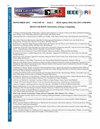Performance study of a photovoltaic system operating on the southeastern coast of Brazil
IF 1.3
4区 工程技术
Q3 COMPUTER SCIENCE, INFORMATION SYSTEMS
引用次数: 0
Abstract
The photovoltaic (PV) solar energy generation sector is expanding fast and achieved 23.9 GW of installed power in Brazil in the first months of 2023 (occupying the 2nd place in installed capacity in the Brazilian electricity mix). Such a scenario makes PV power generation a resource for regional development and socioeconomic opportunities for metropolitan regions with a high national economy share and population density. The present work investigated how a PV systems performance is affected when operating in a coastal area close to high atmospheric particulate and gases emitters like cargo transportation and port operational procedures. The PV system is installed at the Federal University of Sao Paulo, campus Baixada Santista in Santos/SP, close to Latin Americas largest port in trade operations. Santos is a medium-sized coastal city with a tropical climate, dry winters, and humid summers. The evaluation is based on a database including environmental and operational quantities acquired between October/2020 and September/2021 to calculate the fundamental performance metrics: performance ratio, capacity factor, reference and final yields, and system losses. The performance parameters were analogous to published results achieved by PV systems worldwide in coastal and continental areas. The PV system performance at Unifesps Building rooftop was not affected by regional climate and local atmospheric conditions related to the nearby polluting economic activities, including emissions of gases and particulates into the atmosphere. Finally, the PV system showed better performance than that simulated by the SOLergo tool regarding the generated energy, probably due to the influence of local environmental variables and careful operational maintenance not considered in the numerical simulations.在巴西东南海岸运行的光伏系统性能研究
光伏(PV)太阳能发电行业正在快速发展,2023 年前几个月,巴西的装机容量已达到 23.9 千兆瓦(在巴西电力结构中装机容量排名第二)。这种情况使得光伏发电成为地区发展的资源,并为国民经济占比高、人口密度大的大都市地区带来了社会经济机遇。本研究调查了光伏系统在靠近高大气颗粒物和气体排放物(如货物运输和港口作业程序)的沿海地区运行时,其性能会受到哪些影响。光伏系统安装在圣保罗联邦大学桑托斯校区 Baixada Santista,靠近拉丁美洲最大的贸易运营港口。桑托斯是一座中等规模的沿海城市,属热带气候,冬季干燥,夏季潮湿。评估基于一个数据库,其中包括 2020 年 10 月至 2021 年 9 月期间获得的环境和运行数据,用于计算基本性能指标:性能比、容量系数、参考产量和最终产量以及系统损耗。这些性能参数与全球沿海和大陆地区光伏系统已公布的结果类似。Unifesps 大楼屋顶的光伏系统性能不受区域气候和当地大气条件的影响,这些条件与附近的污染性经济活动有关,包括向大气中排放气体和微粒。最后,光伏系统在发电量方面的表现优于 SOLergo 工具的模拟结果,这可能是由于数值模拟中未考虑当地环境变量的影响和精心的运行维护。
本文章由计算机程序翻译,如有差异,请以英文原文为准。
求助全文
约1分钟内获得全文
求助全文
来源期刊

IEEE Latin America Transactions
COMPUTER SCIENCE, INFORMATION SYSTEMS-ENGINEERING, ELECTRICAL & ELECTRONIC
CiteScore
3.50
自引率
7.70%
发文量
192
审稿时长
3-8 weeks
期刊介绍:
IEEE Latin America Transactions (IEEE LATAM) is an interdisciplinary journal focused on the dissemination of original and quality research papers / review articles in Spanish and Portuguese of emerging topics in three main areas: Computing, Electric Energy and Electronics. Some of the sub-areas of the journal are, but not limited to: Automatic control, communications, instrumentation, artificial intelligence, power and industrial electronics, fault diagnosis and detection, transportation electrification, internet of things, electrical machines, circuits and systems, biomedicine and biomedical / haptic applications, secure communications, robotics, sensors and actuators, computer networks, smart grids, among others.
 求助内容:
求助内容: 应助结果提醒方式:
应助结果提醒方式:


